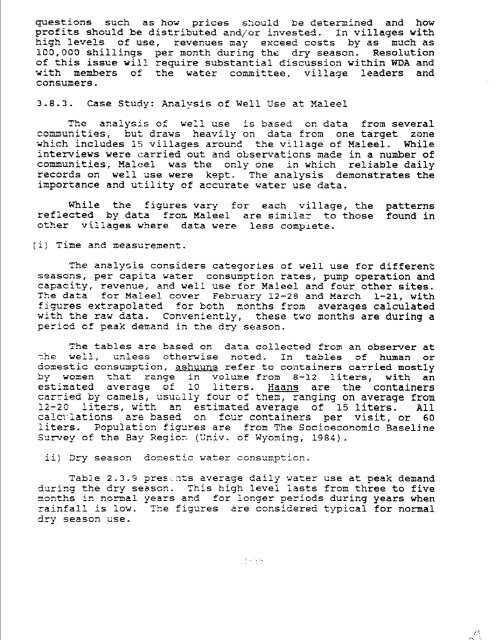r - part - usaid
r - part - usaid
r - part - usaid
You also want an ePaper? Increase the reach of your titles
YUMPU automatically turns print PDFs into web optimized ePapers that Google loves.
questions such as how prices should be datemined and how<br />
profits should be distributed andfar invested. In villagas with<br />
high ZeveLs of use, revenues may exceed costs by as much as<br />
100,000 shillings per month, during thc dry season. Resolution<br />
of this issue w ill require substantial dfsc~ssion within WDA and<br />
with members 02 the water connittee, village Leaders and<br />
consumexs.<br />
3-8.3, Case Study: Analysis of Well Use at %aleel<br />
The acalysis af we21 use Is based cn data from several<br />
comuzities, but draws heavily a2 data from one target zane<br />
which includes 15 villages around the vi3Zage of Mzlesl. While<br />
interviews were carried out and observations made in a number of<br />
cornmitiesf Malcel was the only one in which reliable daily<br />
recards on well xse were kept. Tke analysis demonstrates the<br />
importance and utility of accurate water use data.<br />
While the figures vary for each village, the patterns<br />
reflected By data fro& Haleel are siailaz to rhase found in<br />
other villages where data were less compiete,<br />
The analysis considers categories oE well use for different<br />
seasons, per capita water consumption rates, pump operation and<br />
capacity, revenue, and well use for Maleel and four other sites.<br />
The data for Maleel cover February 12-28 and March 1-21, with<br />
figures extrapolated for bath zonths from averages calculated<br />
with the raw data. Conveniently, these t wo months are during a<br />
period af peak demand in the dry season.<br />
The tables are based an data collected f rom an observer at<br />
:he well, uniess otherwise noted. In tzbles 3f human or<br />
dozestic consmption, a.&xzuns refer ta coi~tainera carried mostly<br />
Sy wozen that ranqe in volume from 8-12 liters, with an<br />
estimated average ~f LO liters. Haam are the containers<br />
carried by cnzefs, usutily four of them, ranging on average from<br />
12-28 liters, with an estiaated average of 15 liters. All<br />
calc!*latians are based on fc~r containers per visit, or 60<br />
liters. ~opulation figares are frcn The Socioeconomic Baseljne<br />
S3,rvey of the say Regfoz (Cniv. of Wyoming, 1984) .<br />
ii'j 3-ry sezscn dozestic w ater consu~ptlcn.<br />
Table 2.3.9 gresczts average daily water use at peak demand<br />
during the 6ry seasan, This high level 12sts from three to five<br />
~02th~ in normal years and for longer periods during years when<br />
rainfall is low. TCe figures are considered typical for normal<br />
dry season cse,

















